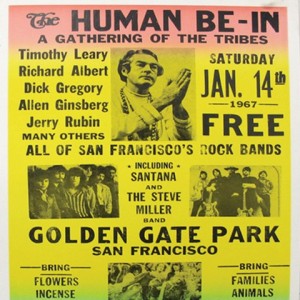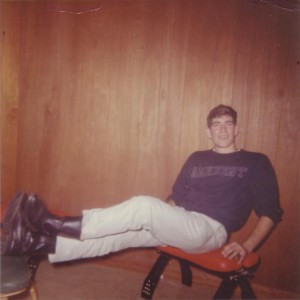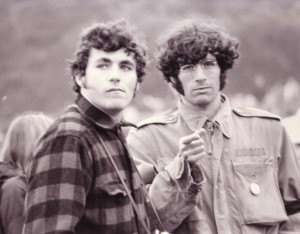By: Olivia Zoratto
“Was I naïve? You bet! Was it a good time to be naïve? Absolutely!! Protesting to rock and roll was actually fun at times, scary at others…but it was always interesting…” stated Dr. Geoffrey Kurland when reflecting on the anti-Vietnam war protests which he attended during the 1960’s. Now, an eminent, valued, and well-respected pulmonary specialist at Children’s Hospital of Pittsburgh, PA, Dr. Kurland has worked for twenty-eight years in his field of profession, ameliorating the lives of his unwell and infirm patients each day. He began his occupation in the year 1988, after graduating from Amherst College and later Stanford University for medical school, where he diligently devoted his time to medicine as an industrious and conscientious student. However, during his time at the university, more events where transpiring on campus than just that of studies. A greater phenomenon was sweeping the nation, transfiguring tranquil and peaceful campuses into locations of riot and uproar amongst liberal minorities. As an influential reaction to the Vietnam War, the phenomenon of anti-war protests evaded America throughout the 1960’s, commencing a new movement towards an adapting American culture.
As an accomplished author, H.W. Brands illustrates in his book The United States Since 1945: American Dreams, many Americans had objected the Vietnam War since its beginning.[1] “They asked whether the status of a small country far away justified the expenditure of American blood and treasure,” Brands quotes as he discusses President Johnson’s decision to further involve the United States with Vietnam in 1965.[2] However, the repercussions of escalating the war were both grim and consequential, as more casualties were reported and troops were drafted, resulting in an immense and commanding expansion of publicity for anti-war protests. An advertisement for the March for Peace in Vietnam stated, “It’s costing YOU $80 million a day! $80 million a day, $30 billion a year–For what? To wound, burn, and kill innocent children…to sacrifice the youth of America before they have their chance to begin their lives as adults…to raise your rent, food, costs…to bomb a peasant country…”[3]
Dr. Kurland, did not challenge nor oppose Brand’s assertion. “The protests brought attention to the war and tried to emphasize the perceived injustice inherent in our participation in it,” he stated, suggesting that the protests themselves were “trying to prop up a regime that, itself, was not democratic.”[4] Additionally, according to Dr. Kurland, the U.S. drafted men from poorer economic backgrounds, placing them in uniform, while those enrolled in higher educational institutions could be exempted, further demonstrating the injustice and inequity of the war.[5]
As the war developed, and the feeling of injustice and inequity expanded, a particular type of non-violent protest grew to popularity as “teach-ins” began arising on college campuses throughout the mid 1960’s. While still in college at Amherst, Dr. Kurland took part in a teach-in protest himself. “They consisted of a group of scholars and academics and were usually run by historians, political scientists, and others who were both passionate about their feelings on the war. In addition, they were also able to focus their attention on historical and political facts that dealt with the war,” Dr. Kurland stated.[6]
Specifically, the teach-in that Dr. Kurland attended was both historically and politically factual, just as he had suggested. “I went to a teach-in and learned something about the complicated history of Viet Nam, a history of its previous occupation by the French, and the true origins of the war in terms of the artificial division of the country into North and South. I won’t go into great detail, but I remember coming back to my dorm with a lot of questions about the validity of the American involvement in the conflict…” said Dr. Kurland.[7] Similarly, many liberal minorities and college students embraced this point of view, as they feared that the news and government pronouncements were inadequate to explain the intricacies of the events occurring in Vietnam.[8]
After Dr. Kurland had graduated from Amherst College, he had found himself in far more “Left” learning place.[9] During this time, American culture was being refined, metamorphosing itself into a nation of drugs and rock and roll. “The music, the style of dress, and the whole emerging “hippy” scene were both infectious, intoxicating (in a good way, no pun intended), and completely different from the life I’d had prior to medical school,” Dr. Kurland stated.[10] However, as the irresistible and contagious lifestyle disseminated throughout America, the protests did as well.
Contemplating on the protests he attended, Dr. Kurland spoke of a few in particular such as the march to support the People’s Park in Berkeley, California in 1969. “The land [of the park] was being considered to house a car park, but meanwhile had turned into a dumping ground of refuse and was a mess,” Dr. Kurland began.[11] “Inspired by the Free Speech Movement at Berkeley as well as the anti-War movement, a local committee of protesters decided to use the land as a park, and planted shrubs and trees, took out the garbage and were cleaning it up with the help and money of local merchants who were tired of the eyesore,” he continued.[12] Regrettably, during this time Ronald Reagan had run for office where his platform included clamping down anti-war protestors and their ilk.[13] “Governor Reagan referred to the University of California, Berkeley as “a haven for communist sympathizers, protesters, and sex deviants…(We all thought he was just missing a good time)” Dr. Kurland joked. However, Reagan later appointed the Highway Patrol and Berkley police to reclaim the park, attracting more protestors who were tear gassed and one student by-stander was shot and killed.[14]
As time progressed, with the park fenced in, a peaceful rally and march throughout Berkeley was instigated by the Berkeley Barb, a local underground newspaper. “Many of us (me included) in the medical school went over, and joined about 30,000 people who marched peacefully through Berkeley, with music playing from the windows of residents and people cheering us on from their windows. Ultimately, the park became…a park; the chancellor of the university, who’d helped to gather the police and Highway Patrol officers, was forced to resign. Berkeley residents took a leftward turn that to some extent remains to this day,” Dr. Kurland discussed as he reflected on this indelible occurrence.[15]

Satirical poster featuring “Blue Meanie” (a cartoon villain referencing the popular Beatles film “Yellow Submarine”). The poster depicts how poorly U.C. Berkeley and the local police managed public opposition to People’s Park.(https://s-media-cache-ak0.pinimg.com/236x/df/5d/6b/df5d6b132f4d9b93d73fbdec0a605401.jpg)
Furthermore, Dr. Kurland attended another protest a few years later in San Francisco, once President Nixon took office because he “had a plan” to end the Vietnam War. “His plan, it seemed, included bombing the neighboring country of Cambodia, which to many of us didn’t seem like the correct way to be ending a war and was actually more like extending it to another country,” Dr. Kurland explained.[16] The protest he attended was a massive rally in Golden Gate Park, consisting of 50,000-75,000 people and an article from the Boston Globe stated “the marching column extended nearly 40 blocks when reinforcing groups joined at three assembly areas along the seven mile parade route.”[17] “We heard speeches deriding Richard Milhouse (emphasis of the Milhouse, by the way) Nixon as going back on his campaign promise, resulting in more unnecessary deaths of Americans and Vietnamese,” he said.[18] Additionally, hundreds carried signs and posters as one quoted the President: “ ‘It will have no effect’. Give Nixon no choice.” and another “45, 595 Americans, 693, 492 Vietnamese killed in the war in Vietnam.”[19]
While the reasoning for the protest was violent and intemperate, the march itself was peaceful according to Dr. Kurland. “The speakers, while vitriolic, didn’t call on us to go around destroying things. The desire to was rebuild…make the country better, making us less of a seemingly imperialist country and more a country willing to tolerate differences in the world just as we like to think we can tolerate differences of opinion here in the USA…” he said.[20] For Dr. Kurland, the rally was a great idea, and a great time for it educated Americans on the war, while also provided entertainment for the adapting culture and “hippy” generation.

Advertisement for the rally in Golden Gate Park(http://cdn8.openculture.com/wp-content/uploads/2014/09/Human_be-in_poster.jpg)
Nonetheless, not all protests served to be as restful and cordial as the rally in Golden Gate Park, being that many resulted in brutality and arrests. Dr. Kurland discussed, in particular, a faculty member at medical school whom had been arrested during a protest, Hadley Kirkman. “At a local protest against the war early in my time at Stanford, Hadley and some others had apparently locked themselves to some building (I’m not sure what the building was, but it apparently was in some way associated with the Government, I think). He was among those arrested and spent the night in jail. It was a transient big deal and word rapidly went around the medical community,” Dr. Kurland recollected.[21] Kirkman became an instantaneous celebrity and was recognized for having the courage to speak his mind, although never participated in other protests.
Unfortunately, Kirkman was only one of a vast majority who were arrested for anti-war protests. An article in the Washington Post, “11 Arrested in Melee after Antiwar Protest” stated, “At least 11 persons, including four juveniles, were arrested in Washington last night during several melees that erupted after a peaceful demonstration against the use of tax dollars for the Vietnam War.”[22] Police were brought in after demonstrators smashed windows in federal office buildings along the Avenue, however some of the more aggressive and belligerent demonstrators threw rocks at the force, resulting in arrests.[23]
Comparably, according to another article in the Washington Post “Protest for Peace Brings 34 Arrests on Steps of Capitol”, “Thirty-four Vietnam War protesters were arrested yesterday on the Capitol steps in two separate incidents after they refused to stop reading the names of 35,000 American war dead.”[24] Moreover, the group’s arrest was similar to arrests made four times earlier in the month by Capitol Police. [25] Evidently, Kirkman’s arrest, the 11 arrested in Melee, and the 34 arrested on the steps of the Capitol, only serve as a few examples of protests and demonstrations, and indicate the escalating feelings of negativity towards the war.
Nevertheless, although sometimes violent, while other times harmonious and undisturbed, Dr. Kurland asserted that anti-war protests did possess value and avail. “Doing things like this with others results in an amazing sense of community, particularly if one is protesting something that one feels is monstrous and too big to be attacked by one person,” he stated.[26] In particular, one of the aspects of the Vietnam War was that it involved the entire U.S. military, the U.S. government, foreign policy, and everything else. “They say it’s hard to fight city hall…it’s both harder (and yet sometimes easier) to fight the government itself. It is somewhat removed (Washington seemed very far away from Amherst and Stanford, for example), and it’s possible in our society to actually disagree with the government and not get put in jail for life,” Dr. Kurland admitted.[27]Those in favor of the war, the government, the unjust society, often went further suggesting that those in opposition should leave the United States. Dr. Kurland, however, felt differently. “It’s my country, so what I think is right about it I accept and what I think is wrong about it I will work to change. I had no interest in leaving my country (after all, it was and is my country, too). I just wanted it to be a better version of my country…” he said[28], a version that many wished for, of concord, harmony, and contentment.
[1] H.W. Brands, American Dreams: The United States since 1945 (New York: Penguin Books, 2010), 152.
[2] Ibid, 152.
[3] “Advertisements” Jesús Colón Collection: Arte Público Hispanic Historical Collection: Series 2.
[4] Interview with Dr. Kurland (email), April 15th, 2016.
[5] Interview with Geoffrey Kurland (email), May 03rd, 2016.
[6] Interview with Geoffrey Kurland (email), May 03rd, 2016.
[7] Interview with Dr. Kurland (email), May 03rd, 2016.
[8] Interview with Dr. Kurland (email), May 03rd, 2016.
[9] Interview with Dr. Kurland (email), May 03rd, 2016.
[10] Interview with Dr. Kurland (email), May 03rd, 2016.
[11] Interview with Dr. Kurland (email), May 03rd, 2016.
[12] Interview with Dr. Kurland (email), May 03rd, 2016.
[13] Interview with Dr. Kurland (email), May 03rd, 2016.
[14] Interview with Dr. Kurland (email), May 03rd, 2016.
[15] Interview with Dr. Kurland (email), May 03rd, 2016.
[16] Interview with Dr. Kurland (email), May 03rd, 2016.
[17] “85,000 attend golden gate protest.”Boston Globe,16 November 1969.76.
[18] Interview with Dr. Kurland (email), May 03rd, 2016.
[19] “85,000 attend golden gate protest.”Boston Globe,16 November 1969.76.
[20] Interview with Dr. Kurland (email), May 03rd, 2016.
[21] Interview with Dr. Kurland (email), May 03rd, 2016.
[22] “11 Arrested in Melee A After Antiwar Protest.” The Washington Post, 16 April 1970. A1.
[23] Ibid, A1.
[24] “Protest for Peace Bring 34 Arrests on Steps of Capitol.” The Washington Post, 19 June 1969. B1.
[25] Ibid, B1.
[26] Interview with Dr. Kurland (email), May 03rd, 2016.
[27] Interview with Dr. Kurland (email), May 03rd, 2016.
[28] Interview with Dr. Kurland (email), May 03rd, 2016.



Leave a Reply